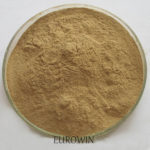Citrus Aurantium Extract – Synephrine
| CAS Number | 94-07-5 |
| Image |  |
Type:Plant Extracts
CAS No:94-07-5
Qty in 20′ FCL:0MT
Min. Order:100KG
QC:Haccp,Kosher,Halal,Iso
Specification:
ITEM STANDARD
Appearance Light-Brown Fine powder
Odor Characteristic
Identification Positive(TLC)
Synephrine NLT 30.0% by HPLC
Loss on Drying NMT 6.0%
Residue on ignition NMT 8.0%
Particle size 80 Mesh 95% Passes
Heavy metals NMT10ppm
Total Plate Count NMT 1000cfu/g
Yeast/Mould NMT100cfu/g
E.Coli Negative
Details :
Synephrine, or, more specifically, p-synephrine, is analkaloid, occurring naturally in some plants and animals, as well as inapproved drugs products in form of its m-substituted analog known asneo-synephrine. p-synephrine (or formerly Sympatol and oxedrine [BAN]) andm-synephrine are known for their longer acting adrenergic effects compared tonorepinephrine. This substance is present at very low concentrations in commonfoodstuffs such as orange juice and other orange (Citrus species) products,both of the “sweet” and “bitter” variety. The preparationsused in Traditional Chinese Medicine (TCM), also known as Zhi Shi, are theimmature and dried whole oranges from Citrus aurantium (Fructus AurantiiImmaturus). Extracts of the same material or purified synephrine are alsomarketed in the US,sometimes in combination with caffeine, as a weight-loss-promoting dietarysupplement for oral consumption. While the traditional preparations have beenin use for millennia as a component of TCM-formulas, synephrine itself is notan approved OTC drug. As a pharmaceutical, m-synephrine is still used as asympathomimetic (i.e. for its hypertensive and vasoconstrictor properties),mostly as a parenteral drug in the treatment of emergencies such as shock andrarely p.o. for the treatment of bronchial problems associated with asthma andhay-fever.
In physical appearance,synephrine is a colorless, crystalline solid and is water-soluble. Itsmolecular structure is based on a phenethylamine skeleton, and is related tothose of many other drugs, and to the major neurotransmitters epinephrine andnorepinephrine.
Some dietary supplements, sold for the purposes ofpromoting weight-loss or providing energy, contain synephrine as one of severalconstituents. Usually, the synephrine is present as a natural component ofCitrus aurantium (“bitter orange”), bound up in the plant matrix, butcould also be of synthetic origin, or a purified phytochemical (i.e. extractedfrom a plant source and purified to chemical homogeneity).,The concentration rangefound by Santana and co-workers in five different supplements purchased in theUS was about 5 – 14 mg/g.